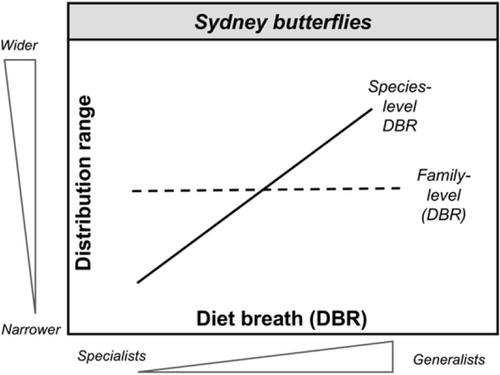当前位置:
X-MOL 学术
›
Insect Conserv. Divers.
›
论文详情
Our official English website, www.x-mol.net, welcomes your
feedback! (Note: you will need to create a separate account there.)
Species‐level, but not family‐level diet breadth predicts geographic distribution of Sydney butterflies
Insect Conservation and Diversity ( IF 3.2 ) Pub Date : 2019-10-11 , DOI: 10.1111/icad.12388 Juliano Morimoto 1
中文翻译:

物种水平而非家庭水平的饮食广度可预测悉尼蝴蝶的地理分布
更新日期:2019-10-11
Insect Conservation and Diversity ( IF 3.2 ) Pub Date : 2019-10-11 , DOI: 10.1111/icad.12388 Juliano Morimoto 1
Affiliation

|
- Diet specialisation drives life‐history adaptations and is an important factor determining the geographic distribution of species.
- Previous empirical studies have shown that diet specialists should compose the majority of species in a given location, and theory predicts that generalists should have higher geographic distribution range compared with specialists (the niche breadth‐range size hypothesis). Although the evidence in support of these predictions remain scarce for herbivorous insects from isolated regions of the world such as Sydney on the east coast of Australia.
- Here, I compiled data from a public database to test these predictions. By measuring the diet breadth and geographic distribution of Sydney butterflies, I showed that species‐, genus‐ and family‐level diet breadth agree with worldwide patterns for Lepidoptera, whereby diet breadth is composed largely of specialist species with a long tail of generalists.
- Furthermore, species‐ and genus‐ (but not family‐)level diet breadths were positively correlated with geographic distribution, providing supporting evidence for the niche breadth‐range size hypothesis.
- A machine‐learning algorithm revealed that the positive relationship between diet breadth and geographic distribution was likely to be influenced by a common evolutionary history amongst species.
- The findings of this study in Sydney butterflies provide support for an important yet debated ecological hypothesis, thereby contributing to our understanding of ecological and nutritional factors driving butterfly species distribution.
中文翻译:

物种水平而非家庭水平的饮食广度可预测悉尼蝴蝶的地理分布
- 饮食专业化推动了生活史的适应,并且是决定物种地理分布的重要因素。
- 以前的经验研究表明,饮食专家应在给定位置组成大多数物种,并且理论预测,与专家相比,通才应具有更高的地理分布范围(利基宽度范围大小假设)。尽管支持这些预测的证据仍然很少来自世界上偏远地区(例如澳大利亚东海岸的悉尼)的食草昆虫。
- 在这里,我从公共数据库编译了数据以测试这些预测。通过测量悉尼蝴蝶的饮食广度和地理分布,我发现物种,属和家庭水平的饮食广度与鳞翅目的全球格局一致,其中饮食广度主要由专长物种组成,具有通才。
- 此外,物种和属(而不是家庭)水平的饮食广度与地理分布呈正相关,为利基广度范围假设提供了支持证据。
- 机器学习算法表明,饮食宽度与地理分布之间的正相关性很可能受到物种间共同进化史的影响。
- 悉尼蝴蝶的这项研究结果为重要但尚有争议的生态学假设提供了支持,从而有助于我们理解驱动蝴蝶物种分布的生态和营养因素。











































 京公网安备 11010802027423号
京公网安备 11010802027423号